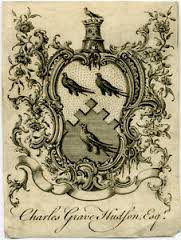Sir Charles Hudson, 1st Baronet
Charles Grave Hudson FRS (3 April 1730 – 24 October 1813) married well and became the owner of Wanlip Hall in Leicestershire. He was a director of the South Sea Company and became a High Sheriff of Leicestershire in 1783. He became a baronet on 21 June 1791.
Charles Grave Hudson | |
|---|---|
 bookplate | |
| Born | 3 April 1730 |
| Died | 24 October 1813 |
| Nationality | Britain |
| Known for | High Sheriff of Leicestershire |
Life

Hudson was born in Tunis in 1730 to Joseph Hudson, a Dutch consul, and Sarah (born Plowman). Charles was the second and last child and only son.[1]
He was elected a Fellow of the Royal Society in 1757 as a ""curious enquirer into natural philosophy" [2]
Hudson married Catherine Susanna Palmer and he and his wife inherited Wanlip Hall in Leicestershire as his wife was a co-heiress (and eldest of four daughters). Their new home had been built in about 1750. Because of the hall, Hudson had to make payments to his wife's sisters to balance the inheritance from his father-in-law, Henry Palmer. Hudson extended and improved this imposing building that stood beside the River Soar.[3] Together they had eight children[1] before Catherine died and Hudson married again.
Hudson had interest in slave plantations in Surinam.[4] He was also a director of the South Sea Company. He became a High Sheriff of Leicestershire in 1784[5] and a baronet in 1791.[6][7]
Legacy
One of Hudson's daughters, Harriet, married Sir John Richardson[8] who was a lawyer in August 1804 at Wanlip. Richardson became a judge.[9] One of his granddaughters was Caroline Harriet Palmer. She feared that she would die a spinster after spending time nursing her mother. She went to New Zealand as the wife of Bishop Charles Abraham and she became a noted artist.[10]
After his death, his 1812 will was successfully challenged after it was considered by the Law Lords. The Master of the Rolls considered that his request that his executors pass on his wealth (2,500 pounds) to the children that were surviving 28 years after his death was too vague and remote.[11]
Wanlip Hall remained in the Palmer family and his baronetcy was passed down via the Palmer line. His son Charles Thomas took the name of Palmer.[12] The hall was demolished in the twentieth century.
References
- The Baronetage of England: Or The History of the English Baronets, William Betham, Vol $, retrieved 28 June 2014
- "Fellows details". Royal Society. Retrieved 22 September 2019.
- Wanlip Hall, European Magazine, 1803, p33, retrieved 1 July 2014
- The Palmer family of Wanlip, Leics.gov.uk, retrieved 6 July 2014
- Topographical History of the County of Leicester
- "No. 13318". The London Gazette. 21 June 1791. p. 363.
- The Gentleman's Magazine (London, England), Volume 114. 1813. p. 406. Retrieved 28 June 2014.
- Lee, Sidney, ed. (1891). . Dictionary of National Biography. 28. London: Smith, Elder & Co.
- The Scots Magazine, Vol 66, 1804
- Caroline Abraham, NZ encyclopedia, retrieved 28 June 2014
- The Law Journal, Volume 6. 1828. Retrieved 28 June 2014.
- Obituary, The Gentleman's Magazine, and Historical Chronicle, Volume 97, Part 1
| Honorary titles | ||
|---|---|---|
| Preceded by Charles Loraine Smith |
High Sheriff of Leicestershire 1784–1785 |
Succeeded by William Vann of Belgrave |
| Baronetage of Great Britain | ||
| New creation | Baronet (of Wanlip Hall) 1791–1813 |
Succeeded by Charles Thomas Hudson Palmer |
|}